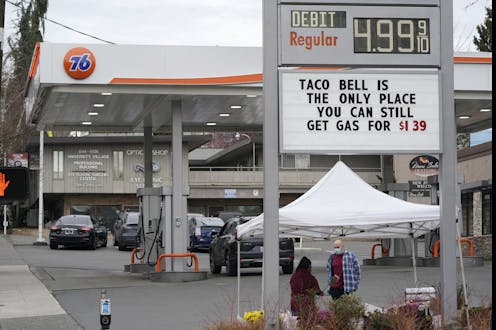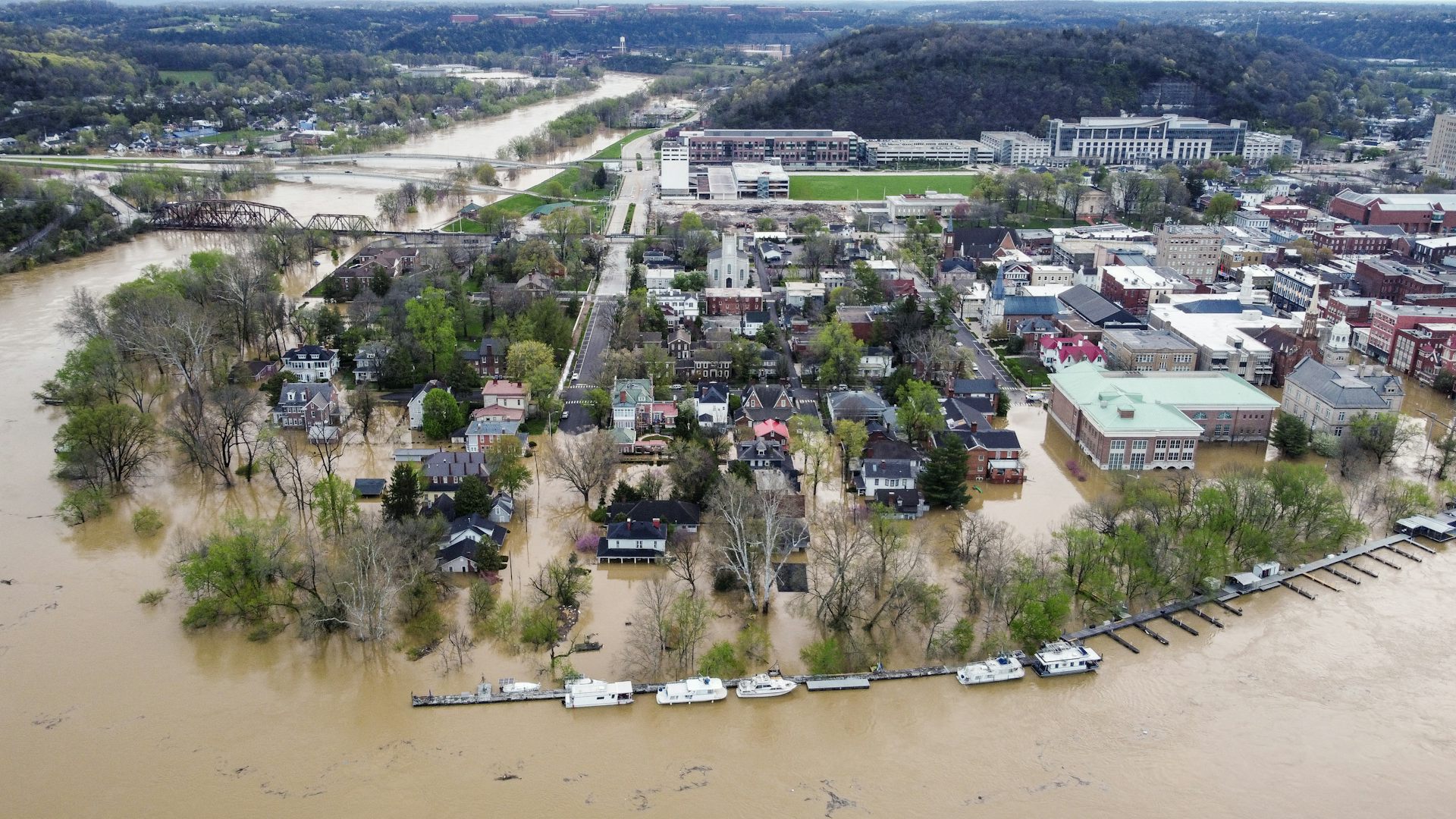Would gas tax breaks make a big difference when prices are skyrocketing? We asked 4 experts
Consumers are feeling pain at the pump and demanding solutions. Some politicians are pushing gasoline tax waivers – but that means less money to fix roads, and often not much economic relief.

With gasoline prices trending over US$4 per gallon nationwide, politicians are feeling the heat. In response, Maryland and Georgia have temporarily waived their state gasoline taxes to reduce the burden on consumers. Other states are considering similar actions, and some members of Congress have called for suspending the federal gas tax. The Conversation asked four experts whether gas tax waivers are an effective way to provide economic relief to U.S. households, and what other impacts these measures could have.
Not a windfall
Jay Zagorsky, Senior Lecturer in Markets, Public Policy and Law, Boston University
As an economist who has studied gasoline prices, I doubt that waiving gas taxes will meaningfully lower prices at the pump. Russia’s invasion of Ukraine boosted gasoline prices dramatically, and politicians feel a need to show voters they are doing something. Cutting gas taxes makes great political theater, but as a few numbers show, it is an ineffective policy.
According to the American Automobile Association, the average price of gasoline in Maryland just before the state’s gas tax holiday was $4.25 per gallon. Two days after the state stopped charging the gas tax, prices were $3.81. A 44-cent drop may look significant, but it’s not that simple.
First, not all of that decrease happened because of eliminating the gas tax. Neither Delaware nor the District of Columbia, both of which border Maryland, had waived their gas taxes. However, over the same time period, Delaware gas prices declined by 19 cents per gallon and D.C. prices fell by almost 16 cents. These drops are partly due to falling oil prices. Florida, which is far from Maryland, saw a 16-cent drop per gallon over this same time period.
The latest U.S. government statistics show that Maryland consumes 4.5 million gallons of gasoline per day. That sounds like a lot, but Maryland has 6 million people. That means the average person consumes about 22 gallons per month. Doing the math, we find that cutting gasoline prices by 44 cents per gallon saves the average person in Maryland about $10 monthly – the price of an average cheese pizza.
Less money to fix roads
Theodore J. Kury, Director of Energy Studies, Public Utility Research Center, University of Florida
Federal highway maintenance is primarily paid for with gas tax revenues that flow into the Highway Trust Fund. The federal levy of 18.4 cents per gallon, unchanged for almost 30 years, is a major component of these revenues, along with taxes on diesel fuel, gasohol, methanol, liquefied gases and compressed natural gas.
The federal government collects roughly $37 billion to $38 billion per year in revenues from the gas tax. These revenues have remained fairly consistent over the past five years, even through the heart of the pandemic. Other highway-related fines and fees also go into the Highway Trust Fund, but their magnitude is comparatively small.
In 2020, the latest year for which numbers are available, the federal government spent roughly $46 billion on highway projects. This figure does not include the subsidies that the federal government extends to state and local governments to reduce the cost of borrowing for highway projects.
But if the government collected $38 billion in gas taxes, where did the other $8 billion come from? Since most politicians strongly resist raising gas taxes, even to pay for much-needed repairs, the government has turned to less transparent alternatives.
Several times in the past decade, officials have shored up the balance in the Highway Trust Fund with intragovernmental transfers from other accounts. Most recently, the Fund received $10 billion this way in October 2020 and $90 billion in December 2021. That represents $100 billion that was not spent providing other services.
If the Highway Trust Fund faces more shortfalls, program managers will either greenlight fewer infrastructure maintenance projects or transfer money from other programs. This would be the most likely outcome if Congress opts to suspend the federal gas tax.
Ultimately, taxpayers pay for everything that the government does. Policymakers simply decide how and when that will happen.
Waivers only help drivers
Erich J. Muehlegger, Associate Professor of Economics, University of California, Davis
Research shows that for decades, lower-income households have spent a larger fraction of their budgets on gasoline than higher-income households. The growing transition to electric vehicles has contributed to this pattern because high-income households in the U.S. have been more likely to go electric and, as a result, pay less in gasoline taxes.
This means that a gas tax holiday tends to benefit lower-income households relatively more than higher-income households – but there are two important caveats.
First, not everyone benefits from a gas tax holiday. The very poor who lack cars, urban households who rely on public transit, and the elderly, who tend to drive less, benefit less from a tax holiday because they consume less gasoline. A gas tax holiday can soften the blow of high gasoline prices for commuters, but it provides little direct benefit to households that do not drive.
Second, even optimistic estimates suggest that gas tax holidays produce relatively modest savings for households. That’s because gasoline taxes are a small component of the price of gasoline in the U.S., especially relative to crude oil prices.
Even if savings from a waiver of the 18.4 cents-per-gallon federal gas tax were entirely passed on to consumers, a typical motorist who drives 10,000 miles per year in a 20 miles-per-gallon Ford F-150 would see about $7.70 in savings per month from a federal gas tax holiday. Drivers of more fuel-efficient vehicles would save even less.
Consider aid for heating and cooling
Sanya Carley, Professor of Public and Environmental Affairs, Indiana University
Millions of Americans face material hardship on a daily basis, and energy costs are a primary contributor. A gas tax waiver could temporarily help relieve people who have to rely on gasoline for transportation and who live in energy poverty.
Current gasoline price spikes are happening at an especially hard time for many households. The winter of 2021-2022 brought frigid temperatures in some regions of the country, and natural gas prices were high. In a recent study, colleagues and I found that 28% of all low-income households struggled to pay their energy bills this past winter, from November through January, and 38% carried debt on their utility accounts.
Now, with higher gasoline prices, filling a 12-gallon tank can cost about $51, up from about $26 in 2020. That increase may prevent households with limited budgets from covering all of their expenses, including basic needs such as food and health care.
Households with vulnerable members, such as small children or people with chronic health issues, are especially burdened by energy expenses than other groups. Temporary relief can be especially helpful for these consumers.
But a gas tax holiday may not be the most effective way to deliver that relief, especially since these waivers are temporary. Direct assistance to households for food and energy spending, or investments in weatherizing homes to reduce their heating and cooling bills, could provide larger and more lasting benefits.
[You’re smart and curious about the world. So are The Conversation’s authors and editors. You can read us daily by subscribing to our newsletter.]
Erich Muehlegger receives funding from the National Science Foundation and has received funding from the State of California Public Transportation Account and the Road Repair and Accountability Act of 2017 (Senate Bill 1) via the University of California Institute of Transportation Studies.
Sanya Carley receives funding from the National Science Foundation, the Alfred P. Sloan Foundation, and the Indiana University Office of the Vice president for Research.
Theodore J. Kury is the Director of Energy Studies at the University of Florida’s Public Utility Research Center, which is sponsored in part by the Florida electric and gas utilities and the Florida Public Service Commission, none of which has editorial control of any of the content the Center produces.
Jay L. Zagorsky ne travaille pas, ne conseille pas, ne possède pas de parts, ne reçoit pas de fonds d'une organisation qui pourrait tirer profit de cet article, et n'a déclaré aucune autre affiliation que son organisme de recherche.
Read These Next
Pardons are political, with modern presidents expanding their use
Trump and Biden have issued pardons at a faster clip than their predecessors. Many of their decisions…
Christmas trees are more expensive than ever in Colorado — what gives?
Most Christmas trees are imported from other states, which drives up costs.
Getting peace right: Why justice needs to be baked into ceasefire agreements – including Ukraine’s
Just war theory, a centuries-old field of ethics, deals with how and when to start conflicts. It can…






